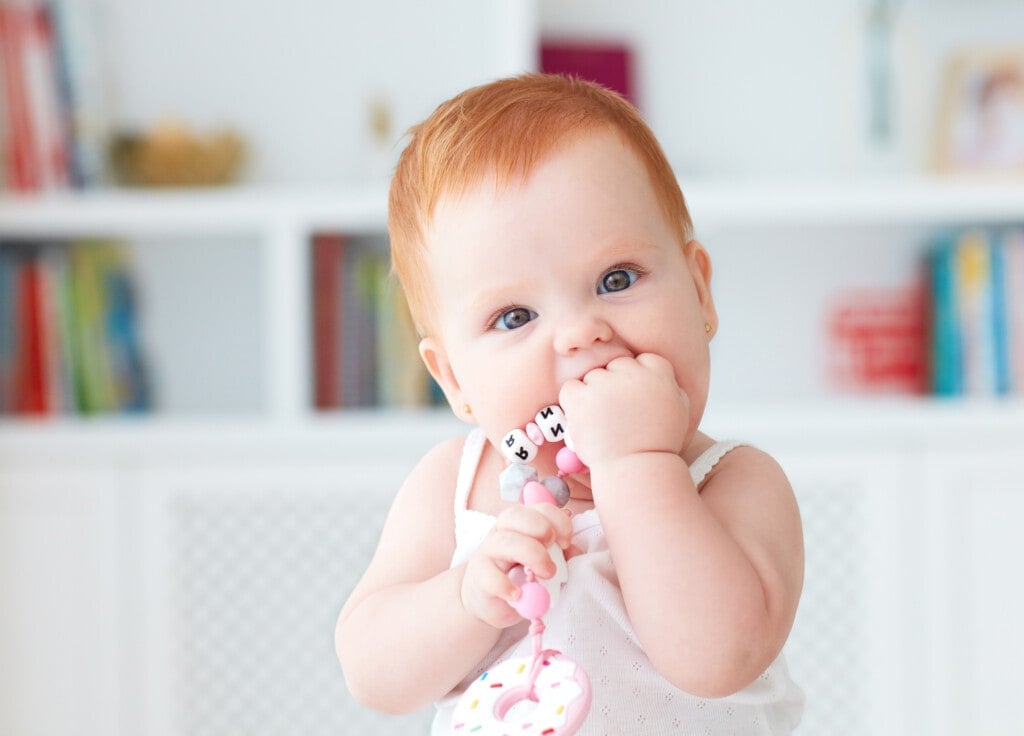As with many stages of development that you will parent your child through, teething can be unpredictable and challenging to navigate. Every child is unique and develops differently. Some babies have significant signs of teething, while others have none before you notice a tooth has suddenly popped through. Unfortunately, some little ones are pretty uncomfortable as they teethe. As parents, we don’t always know what’s wrong or what we can do to help. This can be overwhelming and frustrating for both the parent and child. To make this process a little easier, we’ve put together this guide on how to help your teething baby.
How To Know Whether Your Baby Is Teething
From teething signs and symptoms to proper tooth care, here’s what you need to know about your teething baby:
What Is the Developmental Process of Teeth?
Teeth begin to develop before a baby is even born. According to GoodRx Health, the first stage of tooth development begins at about 6 weeks of gestation as the tooth starts to form. The next stage is around 3-4 months gestation when the hard tissue surrounding the teeth develops. Once the baby is born, the tooth protrudes from the gum.1
The entire teething process in your child can last quite a long time, anywhere from 6-30 months.1 From the time we visualize swelling of the gums, it could take two weeks or longer for any one tooth to break through. Pain and other symptoms specific to teething typically peak in the few days leading up to the tooth erupting.3 This can confuse parents because some things that look like teething are normal developmental milestones and might be mistaken for teething. For example, excess drooling arises when a baby is 3-6 months old as their salivary glands develop.4,5 Babies exploring by putting their hands and objects in their mouth is also a normal milestone at 3-4 months that could be confused for teething.6,7
When Will My Child Get Their First Tooth? Which Will It Be?
The order of teeth eruption may vary. Teeth often come through in pairs, and the most common first teeth are the lower central incisors, and the middle top pair follows not long after.3,6 But there’s no telling which you’ll see first. The age at which you will see your baby’s first tooth also varies from child to child, seemingly with little rhyme or reason. The average age is 6-7 months, but some appear as early as 3-4 months. Others may not emerge until 12 months old or even later.2,3,8
It’s rare, around one in 2,000 births, but some babies are born with teeth called natal teeth. These can be affixed to the root and fully developed, loose without roots, or even just small buds poking through the gums.9
Children typically have all 20 of their primary teeth by age 3.11 The average age at which children begin to lose their teeth is 6 years old, and they will shed all their baby teeth by the time they are 12.2 Usually, girls both get and lose their teeth before boys.10 Another interesting fact is that baby teeth often fall out in the order they came in.10,12
What Are the Signs or Symptoms My Child May Show When Teething?
There are several symptoms and signs of teething, including:1,6,13,14,15
- Irritability
- Excessive drooling (this helps moisten gums and reduces inflammation)
- Mouthing objects, biting (which can be uncomfortable for breastfeeding mothers!), and chewing on hands
- Tender, red, and swollen gums
- Pulling at the ears or rubbing their cheeks
- Slightly elevated temperatures (however, a fever, which is a temperature at or over 100.4 degrees, isn’t normal during teething, so speak to your child’s doctor if this happens!)
- Changes in sleeping or eating patterns
- Loose stools
Studies have not revealed a direct correlation between teething and diaper rash.16 However, new teeth stimulate excess saliva production, including a digestive enzyme that leads to a change in stool acidity with subsequent irritated skin. As prevention, apply an ointment such as petroleum jelly (Vaseline) directly on the skin to act as a protective barrier, allow open air time as able, and use diaper rash creams with zinc oxide when indicated.17 If your child begins to show signs of rash, fever, or diarrhea, you should immediately consult your child’s pediatrician.18
What Can I Do To Help Comfort My Teething Baby?
Here are some tips on how to comfort your child from the first signs of teething:
- Massage their gums. Gently massaging sore or swollen gums with a clean finger can help relieve your baby’s pain or discomfort.1,6
- Feed them cold, soft foods. This could be yogurt, bananas, frozen teething pops made with healthy ingredients, or even breastmilk.
- Try nursing. You can do some extra nursing to help soothe your little one. The rhythmic motion comforts some babies.
- Offer a clean teether to chew on. You want something chilled (freezer-safe), solid, non-toxic (BPA-free), and colorful that your baby can hold and that doesn’t have small parts that can fall off.1 Examples of good teethers are cold spoons, gauze pads, and specially designed firm rubber teething rings.
- Make a washcloth teether. Knot a washcloth on one or both ends, then dip the knot in breastmilk, formula, or water. Put it in the freezer for 15-30 min. Don’t freeze it all the way because there should still be some give so your child can chew on it. Attach it to a pacifier clip or toy, or give it right to your baby.
- Give them medication. You may use children’s acetaminophen (Tylenol) or ibuprofen (Motrin or Advil) if your child seems to be in considerable pain. Read the label to know the correct dose for your child, and check with your child’s doctor first. Do not give ibuprofen to children younger than 6 months.1,6
What Teething Treatments Should I Avoid?
There are a few treatments that we do not recommend for teething:
- Benzocaine and belladonna treatments: Do NOT use numbing gels with benzocaine or homeopathic teething tablets containing belladonna. The FDA warns against using belladonna, which is poisonous, and benzocaine to relieve teething pain.19,20,21
- Amber teething necklaces and bracelets: You also want to avoid giving these to your baby, as they can break into small pieces and lead to accidental choking or strangling.6,22
- Certain teething rings: Do not offer teething rings with fluid inside or plastic objects that might break off.1
How Do I Properly Care For My Baby’s New Teeth?
Remember, oral health starts early. According to the Health Resources and Services Administration, once your child has a tooth, you should begin brushing them twice a day with a fluoride toothpaste the size of a grain of rice, especially after the last drink or food of the day.23 Ask your pediatrician about your child’s teeth and the need for fluoride varnish or supplementation.2,24
In addition, be sure to establish a dental home (aka care with a dental office). All children need access to a dentist for regular maintenance. The American Academy of Pediatrics recommends all children see their dentist by their first birthday or within six months of getting their first tooth. Speak to your pediatrician about the right time for your child, as the appropriate age may depend on risk factors.24
The teething stage can be rough for you and your little one, but we hope this information helps you feel more prepared to help them navigate this uncomfortable process. Remember to talk to your child’s doctor if you have any questions or concerns about how to help your teething baby.
Disclaimer: While I am a doctor, I am not your doctor. All content presented in this article is for educational purposes only. It does not constitute medical advice and does not establish any kind of doctor/patient relationship. Speak to your healthcare provider about any questions or concerns you may have.



































